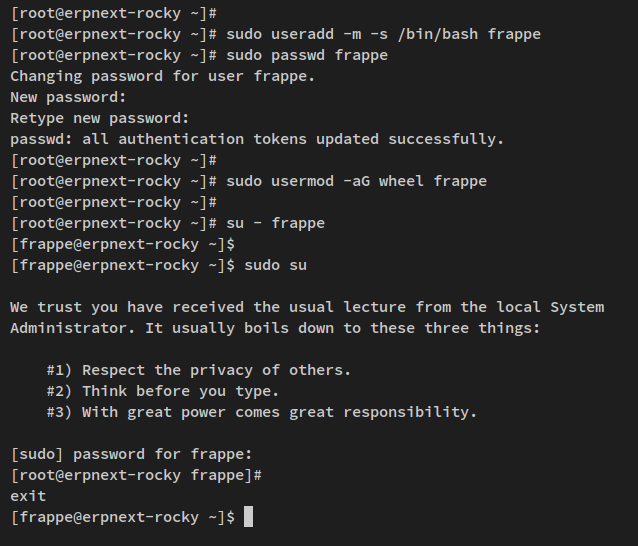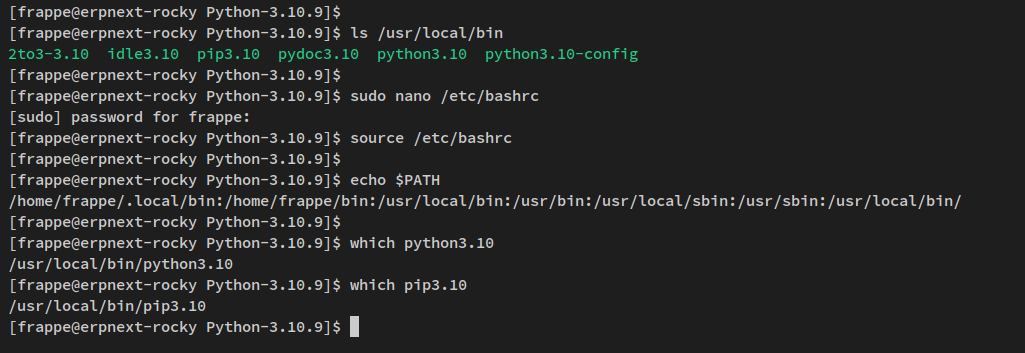ERPNext is an open-source Enterprise Resource Planning system that fits diverse business models, from manufacturing to healthcare. It offers comprehensive modules such as accounting, CRM, and project management, positioning itself as a robust alternative to platforms like Oracle’s NetSuite and Odoo. Developed under the Frappe framework, ERPNext is efficiently written using Python and JavaScript, enhancing its adaptability and performance.
This guide walks you through deploying ERPNext on a Rocky Linux 9 server, emphasizing security with SSL/TLS protocols via Certbot and Letsencrypt. Essential components, including Python 3.10, Redis, Nginx, Supervisor, and MariaDB, will be meticulously set up to ensure a seamless ERPNext environment.
Prerequisites
To successfully install ERPNext, ensure the following:
- A Rocky Linux 9 server
- A non-root user with sudo privileges
- A domain name directed to the server’s IP address
- SELinux set to permissive mode
Creating a User for ERPNext
Create a dedicated user to manage ERPNext:
sudo useradd -m -s /bin/bash frappe sudo passwd frappe sudo usermod -aG wheel frappe
Verify the user creation by logging in:
su - frappe

Installing Python 3.10
To meet Frappe framework requirements, install Python 3.10:
sudo dnf install gcc openssl-devel bzip2-devel libffi-devel zlib-devel wget make wget https://www.python.org/ftp/python/3.10.9/Python-3.10.9.tgz tar xzf Python-3.10.9.tgz cd Python-3.10.9/ ./configure --enable-optimizations sudo make altinstall
Ensure Python 3.10 is correctly added to your system PATH:
echo 'export PATH=$PATH:/usr/local/bin/' | sudo tee -a /etc/bashrc
source /etc/bashrc

Setting Up MariaDB
Prepare your database with MariaDB 10.6:
sudo curl -LsS https://r.mariadb.com/downloads/mariadb_repo_setup | sudo bash -s -- --mariadb-server-version="mariadb-10.6" sudo dnf install MariaDB-server MariaDB-client sudo systemctl start mariadb sudo systemctl enable mariadb
Configure MariaDB:
Edit /etc/my.cnf.d/server.cnf to use utf8mb4:
[mysqld] innodb_file_format=barracuda innodb_file_per_table=1 innodb_large_prefix=1 character-set-client-handshake = FALSE character-set-server = utf8mb4 collation-server = utf8mb4_unicode_ci
sudo systemctl restart mariadb
Secure MariaDB:
sudo mariadb-secure-installation

Installing Additional Dependencies
Deploy various services to enhance ERPNext:
sudo dnf install redis nginx supervisor fail2ban epel-release sudo systemctl enable --now redis nginx supervisor fail2ban
Installing Node.js 16 and Yarn
Set up the necessary environment for ERPNext by adding repositories:
curl -fsSL https://rpm.nodesource.com/setup_16.x | sudo bash - curl -sL https://dl.yarnpkg.com/rpm/yarn.repo | sudo tee /etc/yum.repos.d/yarn.repo sudo dnf install gcc-c++ make nodejs yarn

Installing Wkhtmltopdf
Install Wkhtmltopdf, essential for PDF generation:
sudo dnf install fontconfig freetype libX11 libXext libXrender libjpeg libpng xorg-x11-fonts-75dpi xorg-x11-fonts-Type1 sudo rpm -Uvh https://github.com/wkhtmltopdf/packaging/releases/download/0.12.6.1-2/wkhtmltox-0.12.6.1-2.almalinux9.x86_64.rpm
Setting Up Frappe Bench
Use Frappe Bench to install the framework and ERPNext:
sudo pip3.10 install frappe-bench bench init --python python3.10 --frappe-branch version-14 frappe-bench cd frappe-bench bench new-site erp.hwdomain.io bench use erp.hwdomain.io
Installing ERPNext
Deploy ERPNext on the set domain:
bench get-app payments bench get-app --branch version-14 erpnext bench --site erp.hwdomain.io install-app erpnext bench --site erp.hwdomain.io enable-scheduler bench --site erp.hwdomain.io set-maintenance-mode off
Configuring for Production
Prepare ERPNext for production with Ansible, Nginx, and Supervisor:
sudo bench setup production frappe sudo bench setup supervisor sudo bench setup nginx
Securing with SSL/TLS via Certbot
Enhance security using Certbot:
sudo dnf install certbot python3-certbot-nginx sudo certbot --nginx --agree-tos --no-eff-email --redirect --hsts --staple-ocsp --email admin@hwdomain.io -d erp.hwdomain.io
Conclusion
You’ve successfully installed ERPNext on Rocky Linux. With SSL/TLS security in place, your setup is robust and ready for business operations.
FAQ
What is ERPNext?
ERPNext is an open-source ERP software offering a complete suite of modules for various types of industries.
Why choose ERPNext?
ERPNext is highly customizable, community-driven, and offers comprehensive features at no licensing cost, unlike proprietary solutions.
Is this guide applicable to distributions other than Rocky Linux?
While tailored for Rocky Linux 9, similar steps can be adapted for other RPM-based distributions.
How can I ensure security after installation?
Beyond SSL/TLS, regularly update your server’s packages, configure firewalls, and monitor system logs for suspicious activity.
